Dear reader,
A few weeks ago, I joined some friends for an overnight visit to Emilia, in the hilly area south of Modena. The lighthearted excursion turned out to be an unforgettable gluttony of culinary delights in a location that could not have been more unassuming. I should have had an idea of what we were getting into, given that we were visiting the land famous for Parmigiano Reggiano, prosciutto, and mortadella, among other things. The location? Pensione Ristorante Santina, a homey restaurant and B&B serving typical Emilian dishes for lunch and dinner.
The place
We arrived around 5 p.m. on a Saturday after driving south from Padova for about two hours. Pensione Ristorante Santina is perched on a hill above the town of Rocca Malatina, which lies squarely in Lambrusco Grasparossa di Castelvetro DOC region. Lambrusco of the Grasparossa type is known for its deeper color and fleshier body than the other members of the Lambrusco family and thrives in the hilly area south of Modena. The variety is also called Lambrusco di Castelvetro, after the Medieval town of Castelvetro where the variety is thought to have originated, and which is located just north of Rocca Malatina.

Upon arrival, we were told that the restaurant wasn’t open, as the owner, Imperia, hadn’t arrived. Who were Imperia and Santina? Where exactly were we? We had no idea yet, but we decided to pass the time at a bar down the hill, splitting a couple of Peroni and a pack of patatine, doing our best not to spoil our appetites before dinner.
Two hours later, we received news that Imperia was ready for us, so we trekked back up the hill and checked ourselves in. At this point, our appetite had grown from soft grumbles to an audible roar. Here, I should note the style of overnight accommodations, which can best be described as grandma’s attic meets Medieval farmhouse. While we ascended the dark and stony staircase to our rooms, we passed an impressive array of potted cacti and an unusual collection of dusty old baby dolls. Despite its peculiarities, the place had an air of family—we were staying in someone’s home.
Three generations, one rolling pin
After we had settled our things in the rooms, Imperia called us into the kitchen for a pre-dinner demonstration. This was our first official meeting with Imperia, a fitting name for an impressive woman who owns and runs daily the operations for the B&B and restaurant, along with her daughter Giulia. As the Gazzetta di Modena noted in a July 2024 article, the establishment was founded in 1958 by Santina, Imperia’s mother, and is decidedly matriarchal as it has been owned and operated by three consecutive female generations.1
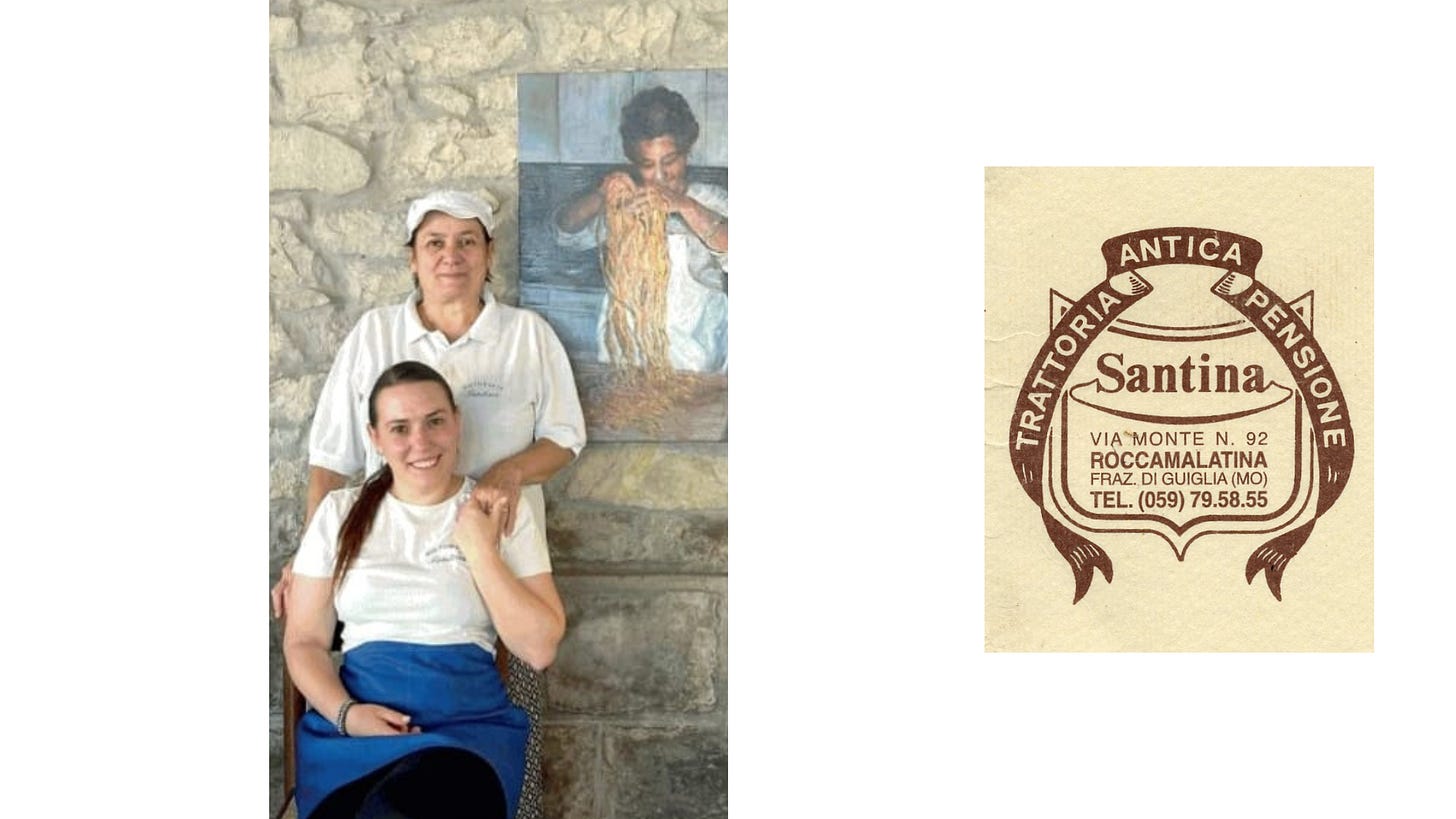
Everything at Santina is handmade, and Imperia shows us, with her rolling pin and one giant sheet of pasta, how she expertly crafts the dough into various shapes, including tagliatelle and a regional specialty, tortellini, which she deftly fills and molds. Imperia invites us to join in, and our lack of skills becomes immediately apparent. We find difficulty in adding the right amount of filling (ricotta & spinach and a savory mixture of Parmigiano, prosciutto and mortadella), while still being able to close the four corners of the tiny pasta, which is smaller than a postage stamp. According to one of our friends who’s joined us on the trip, the size of the tortellini does matter: you should be able to fit eight in a single spoonable bite.
Fried dough and Lambrusco
With newfound appreciation for Imperia’s handiwork, we sat down for dinner at a long wooden table that was already adorned with baskets of white bread and several bottles of, you guessed it, Lambrusco Grasparossa, bottled locally for Santina’s.
First, arrived the pasta. A bit unusual according to Italian mealtime hierarchy, but I guessed that Imperia wanted us to fully appreciate the pasta, rather than filling up on antipasti. After all, you don’t save the best for last when it comes to food and wine.
She served three types:
First, passatelli con tartufo bianco. An egg-and-parmigiano extrusion with an uncanny resemblance to an American childhood favorite, Cheetos. I’d never encountered this type of pasta before, and it is a specialty of Romagna, the eastern half of Emilia Romagna that encompasses the coastal cities of Ravenna and Rimini.2 Imperia’s passatelli had a satisfyingly chewy texture and sublimely cheesy flavor, while the fresh white truffle clung to the pasta’s bumpy exterior.
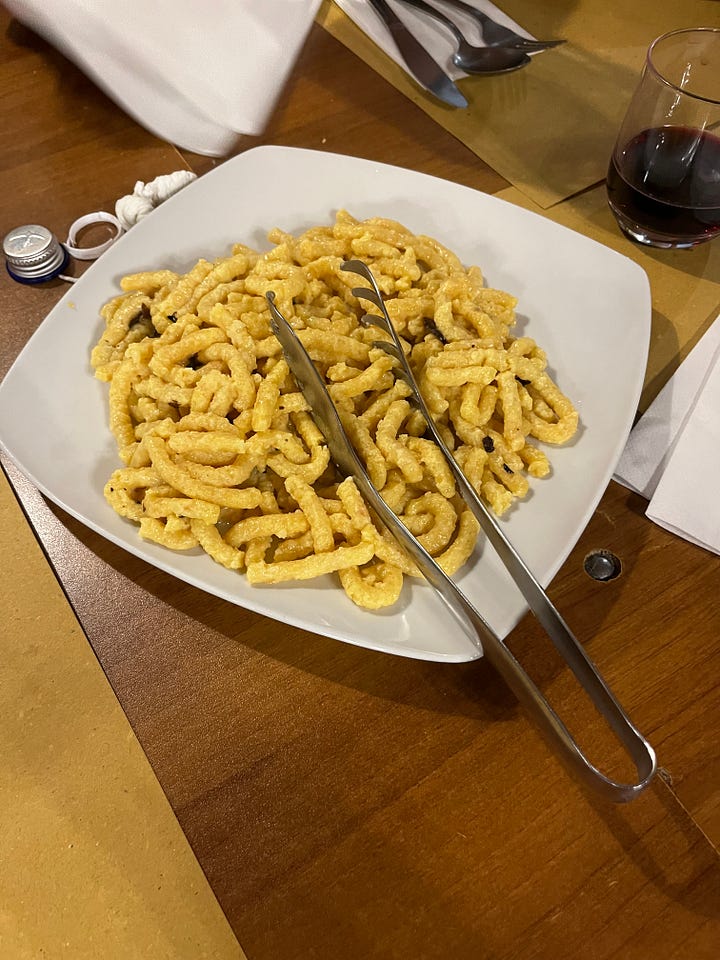

Then, tagliatelle with fungi misti. The pasta tendrils were incredibly tender, and the mushrooms melded together to create a meat-like, umami sughetto that was delicate and light in flavor.
Finally, the pièce de resistance: a steaming pot tortellini in brodo. My one regret from this meal was not eating a second helping of this dish, since Imperia was kind enough to bring us a second pot after we’d devoured the first. The tortellini were impossibly small—yes, you could fit eight in one spoonful—with a savory filling that complemented the rich, chicken-y broth. So simple, yet so complex and satisfying. I dream about this tortellini in brodo.
A jamboree of cured meats, cheeses, jams, and fried dough followed after the pasta.
There was borlengo, another typical Modenese snack with an unusual texture, somewhere between a crepe and crispy papadam. The thin layers of the borlengo were spanked with lard, garlic and herbs before being expertly folded and served to the our table, hot.
Warm tigelle came out in baskets. Also called crescentine, these are small, round, flatbreads. They’re similar to what I know as English muffins, but with a denser interior and the animal flavor of lard. You’re meant to cut them open and load them up with cured meats and cheeses.
Let’s not forget the heaping pile of gnocco fritto—a truly impressive mountain of fried dough served up in waxed brown paper bags. Gnocco fritto are light and airy, and Imperia recommended filling them with the same mixture she used for the tortellini: a porky mix of prosciutto, mortadella and parmigiano with a healthy additional sprinkling of grated parmigiano on top.
Other accoutrements for the breads included creamy stracchino cheese, wedges of salty parmigiano, various salumi, coppa, prosciutto crudo and homemade strawberry and apricot jams. A second regret from this meal: I didn’t ask if I could buy some of this jam to bring home with me.



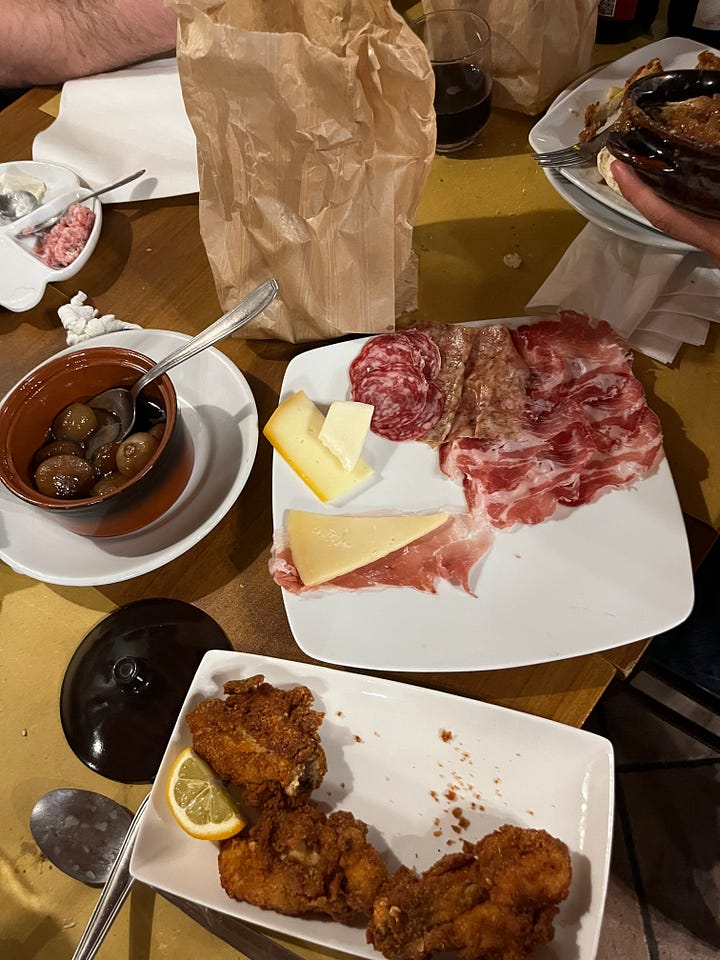
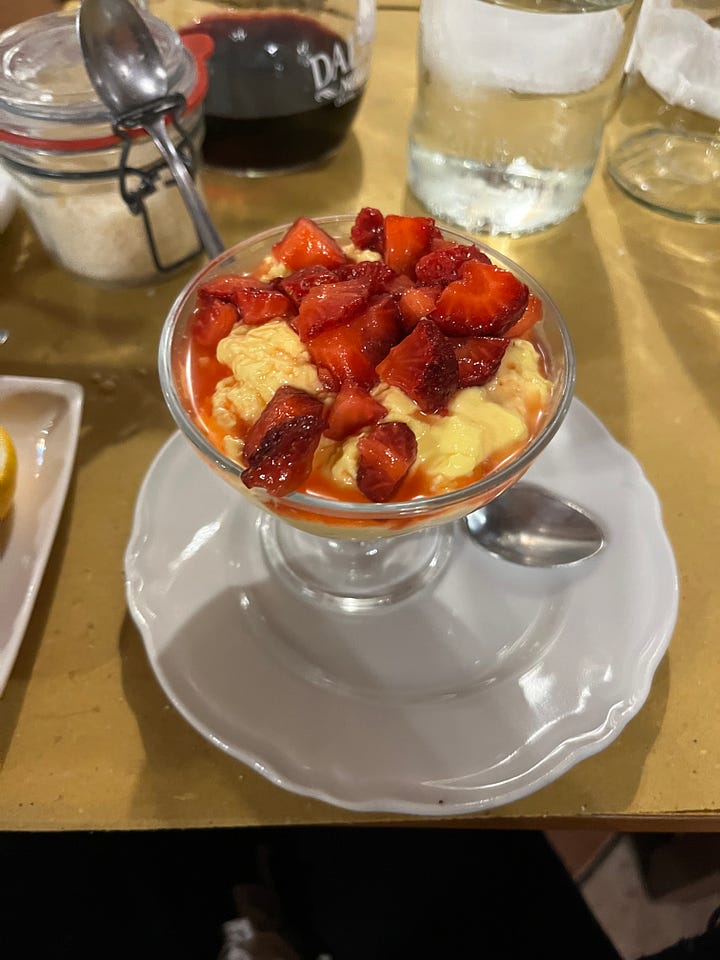
As if we hadn’t eaten enough, more dishes appeared. Plates of extra crunchy fried chicken with lemon wedges, terra cotta pots filled to the brim with chicken cacciatore, braised pork, porcini ragù, and caramelized balsamic pearl onions.
Bottles of Lambrusco Grasparossa continuously reappeared after we emptied them. As mentioned before, this particular variety is more structured and has a deeper, purpler color than its siblings (Lambrusco Salamino and Lambrusco di Sorbara). This version of Grasparossa was dry. Its aromas of ripe black plum and bitter almond, and slight pétillance—a signature of Lambrusco—complemented the diversity of rich flavors on the table and rinsed the palate after each pork-filled bite.
Dessert was crema pasticcera and fresh strawberries, which I barely ate (I couldn’t fit any more food down my gullet at this point). However, our table acquiesced to tasting a trio of unlabeled digestif liquors, followed by caffè. Athena the Lagotto also indulged in the evening’s culinary delights; Imperia graciously let her roam around the kitchen at the end of dinner service.
The next morning, we had a small breakfast of cappuccino and tigelle with prosciutto and homemade jam, before venturing to Parco dei Sassi di Roccamalatina to “walk off” the previous night’s dinner.
After soaking up the views and fresh air, half of us returned to Santina’s for round two of Emilian indulgence, i.e., lunch. Meanwhile, the other half made their way back to Padova (I’ll let you guess which camp I was in).
Though my stomach has yet to recover, I would return to Santina’s in a heartbeat.
- Emma from La Nonna Vita

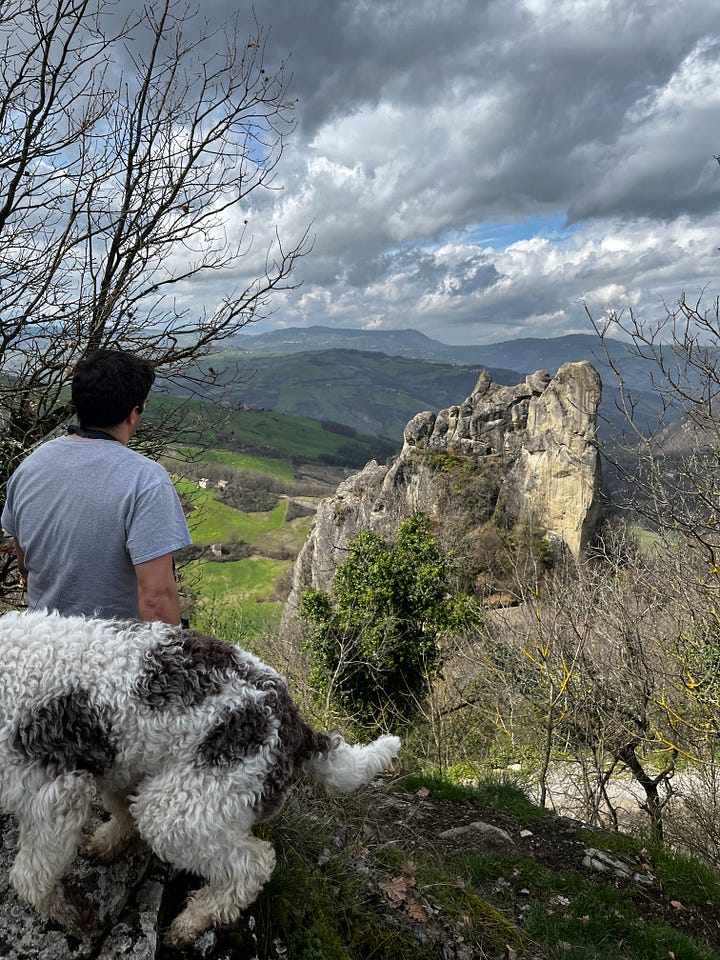
"Roccamalatina, tra il verde dei sassi: Storia e futuro con la Santina," Gazzetta di Modena, July 20, 2024, https://www.gazzettadimodena.it/modena/cronaca/2024/07/20/news/roccamalatina-tra-il-verde-dei-sassi-storia-e-futuro-con-la-santina-1.100557271.
"What Is Passatelli," La Cucina Italiana, accessed April 22, 2025, https://www.lacucinaitaliana.com/glossary/passatelli.





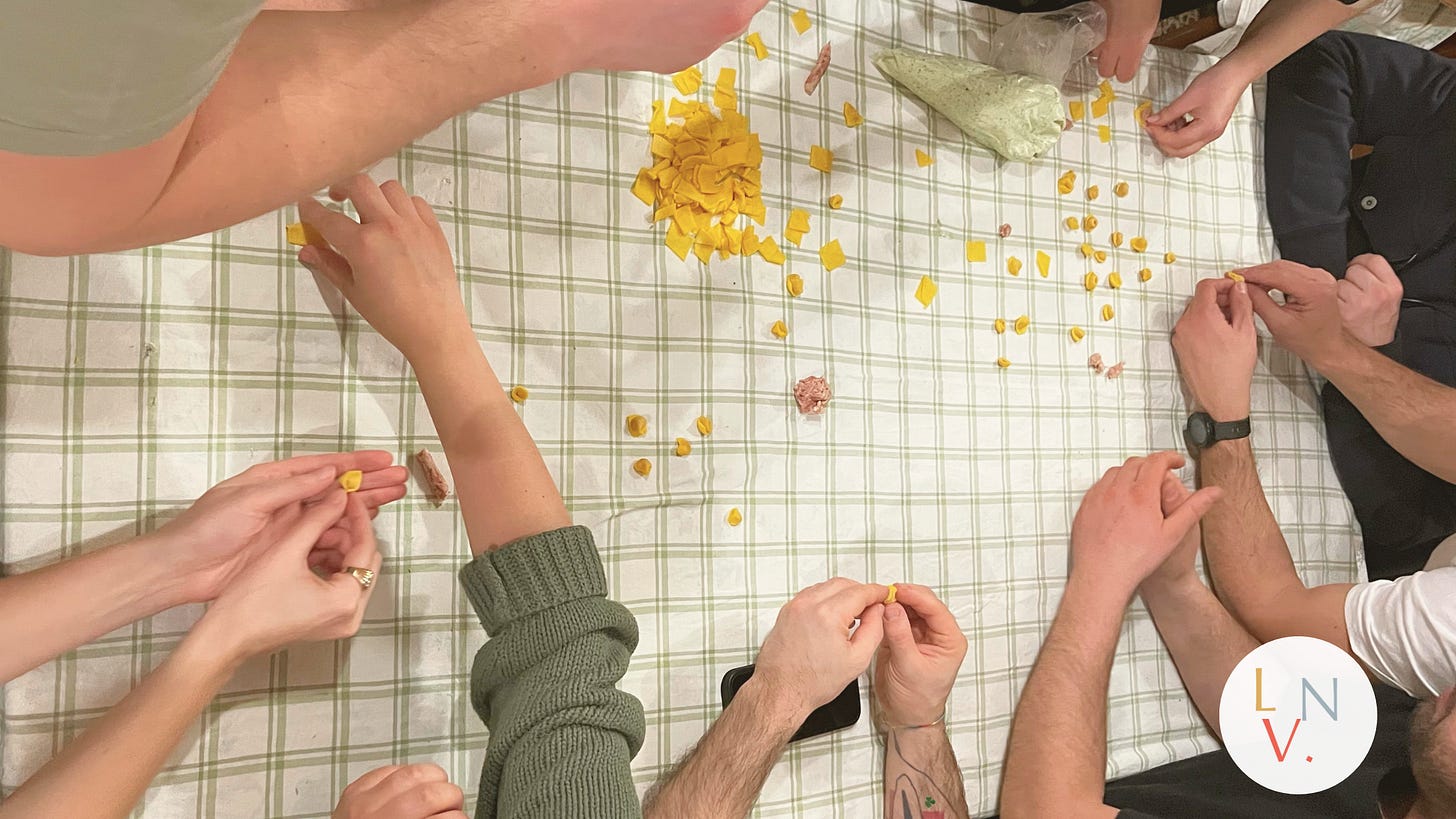



Love this! Reminds me of the Mortadella Focaccia sandwich recipe I adapted from L.A.-based Roman cuisine restaurant Mother Wolf for easy home cooking!
check it out:
https://thesecretingredient.substack.com/p/recreating-evan-funkes-la-mortazza
Brava!